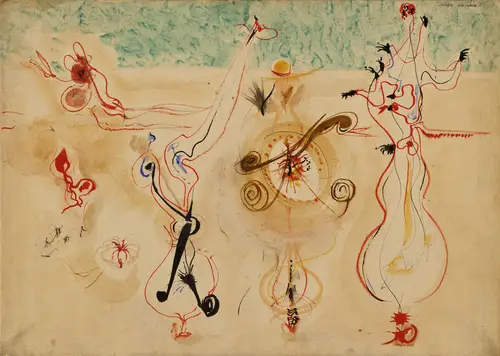The artist incorporates many different media within this painting. There are curved lines of red and blue which form long narrow objects across the centre of the composition as well as a light brown background which slightly varies in tone. Some touches of blue then cut across the top of the painting. There are also black and brown symbols which look similar to musical notes, though with random positions and angles which do not connect with any sort of plan. Other shapes and twists of lines then continue across this relatively light piece. One is immediately interested in the composition, but also entirely confused by its meaning. This appears to be abstract art at its strongest, reducing elements down to a minimum of detail, but without a true meaning established in our minds, we cannot really yet categorise the true artistic nature of the piece. For example, one might place it into Surrealism or Primitivism were there specific meanings attached to the content, but further study is needed here with Untitled (1944-1946).
The painting was put together using watercolor, with additional elements of tempera, ink and pencil on paper. Its owners, MoMA, have listed the piece as being 54 cm in height by 74.9 cm in width. They have close to twenty items from this artist's career in total, including both drawings and paintings. Tempera was an interesting choice from Rothko as this was a method used during the Renaissance and is derived from eggs, but was rarely seen from the Baroque periods onwards, underlining how this 20th century painter would be aware of historical methods and was also happy to experiment with all manner of different ideas, often fusing them together.
MoMA continue to offer one of the finest selections of contemporary art anywhere in the world, making Rothko an important addition to an already excellent display. Rothko's work has been dispersed more widely than almost any other artist, with many major galleries across the US able to offer at least one or two items from his career. This is important as much of the qualities of his work can only really be understood by seeing his work in person, because of the size of many of his paintings, as well as the bold use of colour. Items such as this painting here, though, are not quite in that mould, and are earlier examples of the path that he undertook across his career. We can therefore learn much about his career by browsing these items to see how he progressed over his lifetime to arrive at the highly abstract shapes that came about towards the end. MoMA also brilliantly places his work within the context of the wider American art scene, underlining how other influences altered his own direction from time to time.

